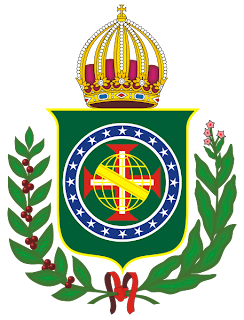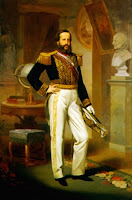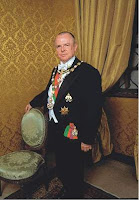Sunday Deposed Monarch Blogging: House Braganza
This is a guest post courtesy of Mr. Trend of Alterdestiny.
 Brazil’s House of Bragança (also spelled Braganza), which ruled Brazil from 1822 to 1889, was a unique experience in Latin America, as it was the only (non-indigenous) monarchy in the Americas. Formed when Dom Pedro I of Portugal declared independence and the establishment of the Brazilian empire in 1822, it had only two emperors in its 77 years – Pedro I and Pedro II, who was ultimately overthrown by the military in 1889, when the Brazilian republic was finally declared.
Brazil’s House of Bragança (also spelled Braganza), which ruled Brazil from 1822 to 1889, was a unique experience in Latin America, as it was the only (non-indigenous) monarchy in the Americas. Formed when Dom Pedro I of Portugal declared independence and the establishment of the Brazilian empire in 1822, it had only two emperors in its 77 years – Pedro I and Pedro II, who was ultimately overthrown by the military in 1889, when the Brazilian republic was finally declared.
The Brazilian House of Bragança is a direct offshoot of the Portuguese house of the same name. The Portuguese Braganças had inherited the throne in 1640, when João II, the Duke of Bragança, successfully led the rebellion against Spain’s control of Portugal (the two crowns had been united under Philip II of Spain in 1580 when the line of succession became muddy), re-establishing the Portuguese monarchy with now-king João IV at its head. The Braganças remained in Portugal until 1808, when Napoleon’s armies invaded the Iberian peninsula. The Bragança court picked up and relocated to Rio de Janeiro, in Brazil, declaring the American colony the capital of the United Kingdom of Portugal, Brazil, and the Algarve (thereby becoming the first European monarchy to rule its empire from a colony).
The Braganças liked Brazil enough that they remained there well after Napoleon had been defeated; only in 1821, with the Portuguese nobles’ threats of rebellion did João VI return to Portugal from Brazil. Upon his return, he demoted Brazil back to a colony, leaving his son Pedro I as regent in Brazil. However, after 13 years of serving as a political center, Brazilian elites and politicians did not want to return to being a colony, and when Pedro was ordered to return to Portugal, he refused. After several incidences between Brazilians and Portuguese troops in Recife and Bahia (involving bloodshed and guerilla warfare), and on September 7, 1822, after gaining the support of the states of Minas Gerais and São Paulo, Pedro I formally broke with Portugal, creating the Empire of Brazil. (It’s most likely he did so after being pressured by Brazilians interested in breaking with Portugal, though some biographers insist he did it of his own free will and his love of freedom – either way, the thought of being emperor of Brazil instead of waiting for his dad to die and Pedro’s ascension to the Portuguese thrown must have seemed like a pretty sweet deal to Pedro I).
Pedro I’s honeymoon with his new empire was short-lived. By 1824, he had already closed the Constituent Assembly when the latter drafted a constitution that would limit Pedro I’s powers, making him an equal to the judicial and legislative branches in the way the President of the United States was. With the Assembly dissolved, Pedro established indirect elections and gave himself “moderating powers” over all elections and the right to appoint “senators for life.” Pedro I also made few friends in his effort to abolish slavery. Brazil’s economy, based on coffee and sugar, had become extremely dependent upon slave-labor, and the slavocracy had enough control in the government to prevent any real efforts at abolition. Tensions between Pedro I and Brazilian elites and nativists grew, and when the military and the people turned against him after he dismissed his cabinet in 1831, Pedro I abdicated and returned to Portugal, leaving the throne to his 5-year-old son, Pedro II.
 During the 9-year regency of Pedro II, Brazil’s political landscape changed, as the different regions of the country gained more control as the government in Rio de Janeiro decentralized its authority. A number of small revolts broke out sporadically throughout the country over a number of issuese, including secession, slavery, and even the restoration of the monarchy in place of the regency. With this turmoil, elites who hungered for a stonger nation-state, supported Pedro II’s ascension as emperor in 1840, when he was still only 14 years old.
During the 9-year regency of Pedro II, Brazil’s political landscape changed, as the different regions of the country gained more control as the government in Rio de Janeiro decentralized its authority. A number of small revolts broke out sporadically throughout the country over a number of issuese, including secession, slavery, and even the restoration of the monarchy in place of the regency. With this turmoil, elites who hungered for a stonger nation-state, supported Pedro II’s ascension as emperor in 1840, when he was still only 14 years old.
Pedro II would govern Brazil for another 49 years. In this time, he strongly re-centralized his authority, using the 1824 Constitution to act as a “moderating power,” continuing to dismiss the legislature, declare new elections, and appoint senators. On the slave issue, Pedro II was predictably slow to act. Brazil only ended the slave trade in 1850, when the United Kingdom exerted pressure (including authorizing British ships to seize slave ships heading for Brazil), yet slavery continued to be central to the Brazilian economy, and the internal slave market remained strong, especially as slave-owners in the Northeast’s sugar-based-economy began selling slaves to their counterparts in the growing coffee-economy of Rio de Janeiro and São Paulo.
As time went on, Pedro II’s power gradually diminished, although it wasn’t always obvious at the time. Of particular importance was the War of the Triple Alliance (1864-1870), which saw Brazil, Uruguay, and Argentina going to war with Paraguay. Argentina and Uruguay quickly withdrew their troops, leaving Brazil’s unprepared and under-equipped army to face a strong, organized, and much larger Paraguayan army. Both sides villified the other in strong racial terms (Brazil characterizing Paraguay as a bunch of uneducated Guaraní Indians; Paraguay portraying Brazil as a bunch of racially-mixed slaveowners). Brazil eventually won the war, with upwards of 50% of Paraguay’s population dying (much of it from disease). However, the war revealed the Brazilian military’s lack of organization and material, for which they blamed the government. From this point onward, the military in Brazil would be a political actor, and its dissatisfaction with Pedro II only grew in the coming years.
Pedro II’s rule gradually unraveled in the 1870s and 1880s. Brazilian republican sentiment was growing rapidly, stoking anti-monarchical sentiment. The War of the Triple Alliance had left the military brass disenchanted in its perception of the monarchy, and as more and more officers entered politics, they chipped away at the Crown’s power and authority. The Catholic Church also caused problems for Pedro II, whose government entered into conflict with the Church in the wake of the First Vatican Council, where the Church authorities established papal infallibility and the Vatican’s control over the Church worldwide. Pedro II continued to try to exercise his authority over the Church, leading to a crisis between the Church and the State.
The slavery issue was the final nail in the coffin for the Portuguese Crown. Brazil had already been working towards abolition, freeing slaves who served in the military in the War of the Triple Alliance. In 1871, the state established the freedom of any child born to a slave woman, and in 1885, it freed all slaves who were 60 years old or older. Attitudes throughout society had been gradually shifting in favor of abolition, even among landowning elites and planters, who had begun using immigrant labor to replace slave-labor. Slaves were freely abandoning plantations, and in 1888, Princess Isabel abolished slavery. No longer dependent on the emperor to defend their slave-holding interests, plantation owners supported republicans and the military in demonstrations against Pedro II. On November , 1889, Pedro II was overthrown, bringing to an end Brazil’s House of Bragança.
 The heir to the throne, Princess Isabel, returned to Portugal with her mother and father. The line of ascendence passed to her son, Dom Pedro Henrique de Orleans de Bragança. Today, Isabel’s grandson, Dom Luís Gastão Maria José Pio Miguel Gabriel Rafael Gonzaga de Orléans e Bragança e Wittelsbach (who turns 70 on June 6 this year) is the heir to Brazil’s throne, having assumed that position upon the death of his father, Dom Pedro Henrique Afonso Filipe Maria Gastão Miguel Gabriel Rafael Gonzaga de Orléans e Bragança e Bourbon, in 1981. Born in France, Dom Luís moved to Brazil in 1945, and currently lives in São Paulo. The likelihood of the House of Bragança’s return to Brazil’s throne seems microscopic, particularly given that the current leader, popularly-elected president Luís Inácio “Lula” da Silva, a former metalworker and union leader, is as far from inherited royalty as one can be. The Brazilian people have seemed to cast their stone, and it is not to the House of Bragança’s favor.
The heir to the throne, Princess Isabel, returned to Portugal with her mother and father. The line of ascendence passed to her son, Dom Pedro Henrique de Orleans de Bragança. Today, Isabel’s grandson, Dom Luís Gastão Maria José Pio Miguel Gabriel Rafael Gonzaga de Orléans e Bragança e Wittelsbach (who turns 70 on June 6 this year) is the heir to Brazil’s throne, having assumed that position upon the death of his father, Dom Pedro Henrique Afonso Filipe Maria Gastão Miguel Gabriel Rafael Gonzaga de Orléans e Bragança e Bourbon, in 1981. Born in France, Dom Luís moved to Brazil in 1945, and currently lives in São Paulo. The likelihood of the House of Bragança’s return to Brazil’s throne seems microscopic, particularly given that the current leader, popularly-elected president Luís Inácio “Lula” da Silva, a former metalworker and union leader, is as far from inherited royalty as one can be. The Brazilian people have seemed to cast their stone, and it is not to the House of Bragança’s favor.
Trivia: The last King of what dynasty rose to the throne after narrowly surviving an assassination attempt that killed the reigning King and the Crown Prince?
Cross-posted to Alterdestiny.


